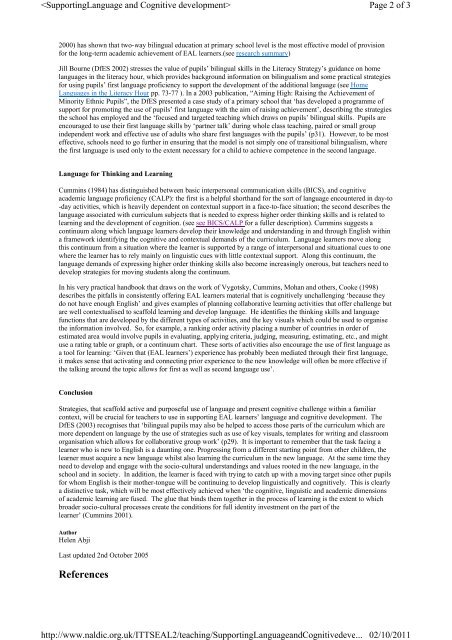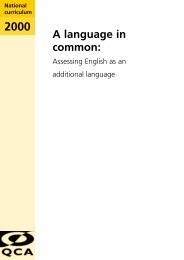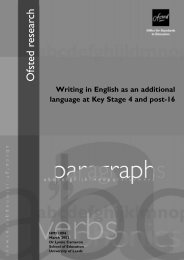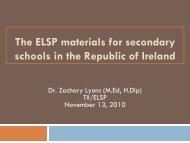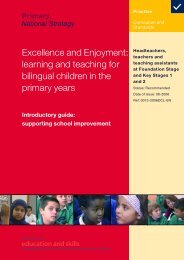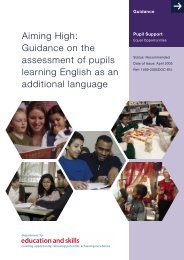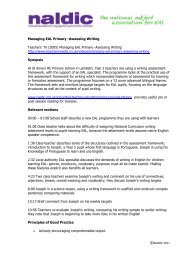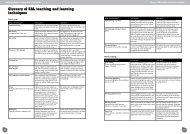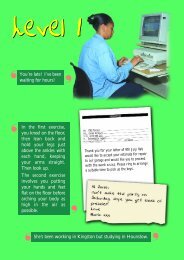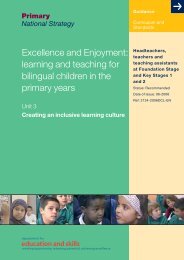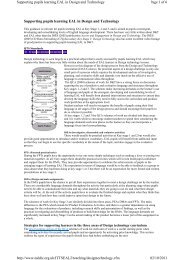Supporting Language and Cognitive Development - NALDIC
Supporting Language and Cognitive Development - NALDIC
Supporting Language and Cognitive Development - NALDIC
You also want an ePaper? Increase the reach of your titles
YUMPU automatically turns print PDFs into web optimized ePapers that Google loves.
http://www.naldic.org.uk/ITTSEAL2/teaching/<strong>Supporting</strong><strong>Language</strong><strong>and</strong><strong>Cognitive</strong>deve...Page 2 of 302/10/20112000) has shown that two-way bilingual education at primary school level is the most effective model of provisionfor the long-term academic achievement of EAL learners.(see research summary)Jill Bourne (DfES 2002) stresses the value of pupils’ bilingual skills in the Literacy Strategy’s guidance on homelanguages in the literacy hour, which provides background information on bilingualism <strong>and</strong> some practical strategiesfor using pupils’ first language proficiency to support the development of the additional language (see Home<strong>Language</strong>s in the Literacy Hour pp. 73-77 ). In a 2003 publication, “Aiming High: Raising the Achievement ofMinority Ethnic Pupils”, the DfES presented a case study of a primary school that ‘has developed a programme ofsupport for promoting the use of pupils’ first language with the aim of raising achievement’, describing the strategiesthe school has employed <strong>and</strong> the ‘focused <strong>and</strong> targeted teaching which draws on pupils’ bilingual skills. Pupils areencouraged to use their first language skills by ‘partner talk’ during whole class teaching, paired or small groupindependent work <strong>and</strong> effective use of adults who share first languages with the pupils’ (p31). However, to be mosteffective, schools need to go further in ensuring that the model is not simply one of transitional bilingualism, wherethe first language is used only to the extent necessary for a child to achieve competence in the second language.<strong>Language</strong> for Thinking <strong>and</strong> LearningCummins (1984) has distinguished between basic interpersonal communication skills (BICS), <strong>and</strong> cognitiveacademic language proficiency (CALP): the first is a helpful shorth<strong>and</strong> for the sort of language encountered in day-to-day activities, which is heavily dependent on contextual support in a face-to-face situation; the second describes thelanguage associated with curriculum subjects that is needed to express higher order thinking skills <strong>and</strong> is related tolearning <strong>and</strong> the development of cognition. (see see BICS/CALP for a fuller description). Cummins suggests acontinuum along which language learners develop their knowledge <strong>and</strong> underst<strong>and</strong>ing in <strong>and</strong> through English withina framework identifying the cognitive <strong>and</strong> contextual dem<strong>and</strong>s of the curriculum. <strong>Language</strong> learners move alongthis continuum from a situation where the learner is supported by a range of interpersonal <strong>and</strong> situational cues to onewhere the learner has to rely mainly on linguistic cues with little contextual support. Along this continuum, thelanguage dem<strong>and</strong>s of expressing higher order thinking skills also become increasingly onerous, but teachers need todevelop strategies for moving students along the continuum.In his very practical h<strong>and</strong>book that draws on the work of Vygotsky, Cummins, Mohan <strong>and</strong> others, Cooke (1998)describes the pitfalls in consistently offering EAL learners material that is cognitively unchallenging ‘because theydo not have enough English’ <strong>and</strong> gives examples of planning collaborative learning activities that offer challenge butare well contextualised to scaffold learning <strong>and</strong> develop language. He identifies the thinking skills <strong>and</strong> languagefunctions that are developed by the different types of activities, <strong>and</strong> the key visuals which could be used to organisethe information involved. So, for example, a ranking order activity placing a number of countries in order ofestimated area would involve pupils in evaluating, applying criteria, judging, measuring, estimating, etc., <strong>and</strong> mightuse a rating table or graph, or a continuum chart. These sorts of activities also encourage the use of first language asa tool for learning: ‘Given that (EAL learners’) experience has probably been mediated through their first language,it makes sense that activating <strong>and</strong> connecting prior experience to the new knowledge will often be more effective ifthe talking around the topic allows for first as well as second language use’.ConclusionStrategies, that scaffold active <strong>and</strong> purposeful use of language <strong>and</strong> present cognitive challenge within a familiarcontext, will be crucial for teachers to use in supporting EAL learners’ language <strong>and</strong> cognitive development. TheDfES (2003) recognises that ‘bilingual pupils may also be helped to access those parts of the curriculum which aremore dependent on language by the use of strategies such as use of key visuals, templates for writing <strong>and</strong> classroomorganisation which allows for collaborative group work’ (p29). It is important to remember that the task facing alearner who is new to English is a daunting one. Progressing from a different starting point from other children, thelearner must acquire a new language whilst also learning the curriculum in the new language. At the same time theyneed to develop <strong>and</strong> engage with the socio-cultural underst<strong>and</strong>ings <strong>and</strong> values rooted in the new language, in theschool <strong>and</strong> in society. In addition, the learner is faced with trying to catch up with a moving target since other pupilsfor whom English is their mother-tongue will be continuing to develop linguistically <strong>and</strong> cognitively. This is clearlya distinctive task, which will be most effectively achieved when ‘the cognitive, linguistic <strong>and</strong> academic dimensionsof academic learning are fused. The glue that binds them together in the process of learning is the extent to whichbroader socio-cultural processes create the conditions for full identity investment on the part of thelearner’ (Cummins 2001).AuthorHelen AbjiLast updated 2nd October 2005References


